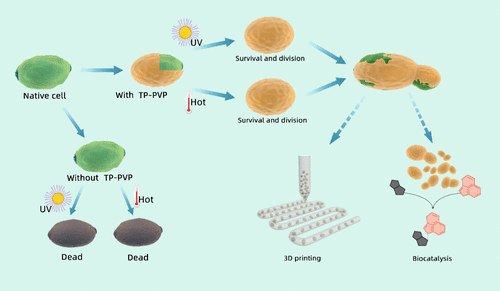当前位置:
X-MOL 学术
›
ACS Biomater. Sci. Eng.
›
论文详情
Our official English website, www.x-mol.net, welcomes your
feedback! (Note: you will need to create a separate account there.)
Synthesis of a Removable Cytoprotective Exoskeleton by Tea Polyphenol Complexes for Living Cell Encapsulation
ACS Biomaterials Science & Engineering ( IF 5.4 ) Pub Date : 2021-01-07 , DOI: 10.1021/acsbiomaterials.0c01617 Wei Chen 1 , Zhao Yang 1 , Xingchuang Fu 1 , Liping Du 1, 2 , Yulan Tian 1 , Jian Wang 1 , Wen Cai 1 , Ping Guo 1 , Chunsheng Wu 1
ACS Biomaterials Science & Engineering ( IF 5.4 ) Pub Date : 2021-01-07 , DOI: 10.1021/acsbiomaterials.0c01617 Wei Chen 1 , Zhao Yang 1 , Xingchuang Fu 1 , Liping Du 1, 2 , Yulan Tian 1 , Jian Wang 1 , Wen Cai 1 , Ping Guo 1 , Chunsheng Wu 1
Affiliation

|
Cell encapsulation is a chemical tool for endowing living cells with exogenous properties and enhancing their in vitro tolerance against lethal factors, which has shown promising prospects and potential applications in many fields such as cell transplantation, drug delivery, and tissue engineering. One-pot precipitation of a polyphenol–metal complex on cells protects cells from UV irradiation and lytic enzymes. However, the involvement of metal ions brings side effects on cell viability and growth. Moreover, an external removal agent is needed for cell division and growth. Herein, a polymer shell composed of hydrogen bonded constituents without affecting cell viability and growth by the precipitation of tea polyphenol and polyvinyl pyrrolidone is reported. The formation of the polymer shell was verified by the Au nanoparticle’s laser scanning confocal reflectance and quartz crystal microbalance measurement. The thickness of the shell was managed by the concentration of the complex. When exposed to UV irradiation for 15 or 30 min, polymer-coating-protected Saccharomyces cerevisiae (yeast) had much higher cell viability than the native one. Exposed to a high temperature environment (60 °C), most of the coated yeasts survived in contrast to uncoated ones. For the cell division and growth curve, the polymer coating with various thicknesses had no difference to the native one, which indicated no suppression of cell growth and no external side effects involved. As applied to mammalian HeLa cells under UV irradiation for 15 min, the coated cells had an obvious higher cell viability than that of untreated ones. Therefore, the tea polyphenol–poly(vinylpyrrolidone) shell is a versatile tool for chemically controlling the external properties of cells without side effects on cell viability and growth.
中文翻译:

茶多酚配合物用于活细胞封装的可移动的细胞保护性外骨骼的合成。
细胞包封是赋予活细胞以外源特性并增强其体外活力的化学工具对致死因子的耐受性,在细胞移植,药物递送和组织工程等许多领域都显示出了广阔的前景和潜在的应用前景。一锅中多酚-金属络合物在细胞上的沉淀可保护细胞免受紫外线辐射和裂解酶的伤害。然而,金属离子的参与对细胞活力和生长带来副作用。而且,细胞分裂和生长需要外部去除剂。本文中,报道了由氢键结合的成分组成的聚合物壳,其不通过茶多酚和聚乙烯吡咯烷酮的沉淀而影响细胞生存力和生长。通过金纳米粒子的激光扫描共聚焦反射率和石英晶体微量天平测量,验证了聚合物壳的形成。壳的厚度由配合物的浓度控制。当暴露于紫外线照射15或30分钟时,聚合物涂层保护酿酒酵母(酵母)具有比天然酵母更高的细胞活力。暴露于高温环境(60°C)中,与未包被的酵母相比,大多数被包被的酵母都能存活。对于细胞分裂和生长曲线,具有各种厚度的聚合物涂层与天然涂层没有差异,这表明没有抑制细胞生长并且不涉及外部副作用。在紫外线照射下15分钟施用于哺乳动物HeLa细胞后,被包被的细胞比未处理的细胞具有明显更高的细胞活力。因此,茶多酚-聚(乙烯基吡咯烷酮)壳是一种用于化学控制细胞外部特性而又不影响细胞活力和生长的多功能工具。
更新日期:2021-02-08
中文翻译:

茶多酚配合物用于活细胞封装的可移动的细胞保护性外骨骼的合成。
细胞包封是赋予活细胞以外源特性并增强其体外活力的化学工具对致死因子的耐受性,在细胞移植,药物递送和组织工程等许多领域都显示出了广阔的前景和潜在的应用前景。一锅中多酚-金属络合物在细胞上的沉淀可保护细胞免受紫外线辐射和裂解酶的伤害。然而,金属离子的参与对细胞活力和生长带来副作用。而且,细胞分裂和生长需要外部去除剂。本文中,报道了由氢键结合的成分组成的聚合物壳,其不通过茶多酚和聚乙烯吡咯烷酮的沉淀而影响细胞生存力和生长。通过金纳米粒子的激光扫描共聚焦反射率和石英晶体微量天平测量,验证了聚合物壳的形成。壳的厚度由配合物的浓度控制。当暴露于紫外线照射15或30分钟时,聚合物涂层保护酿酒酵母(酵母)具有比天然酵母更高的细胞活力。暴露于高温环境(60°C)中,与未包被的酵母相比,大多数被包被的酵母都能存活。对于细胞分裂和生长曲线,具有各种厚度的聚合物涂层与天然涂层没有差异,这表明没有抑制细胞生长并且不涉及外部副作用。在紫外线照射下15分钟施用于哺乳动物HeLa细胞后,被包被的细胞比未处理的细胞具有明显更高的细胞活力。因此,茶多酚-聚(乙烯基吡咯烷酮)壳是一种用于化学控制细胞外部特性而又不影响细胞活力和生长的多功能工具。











































 京公网安备 11010802027423号
京公网安备 11010802027423号